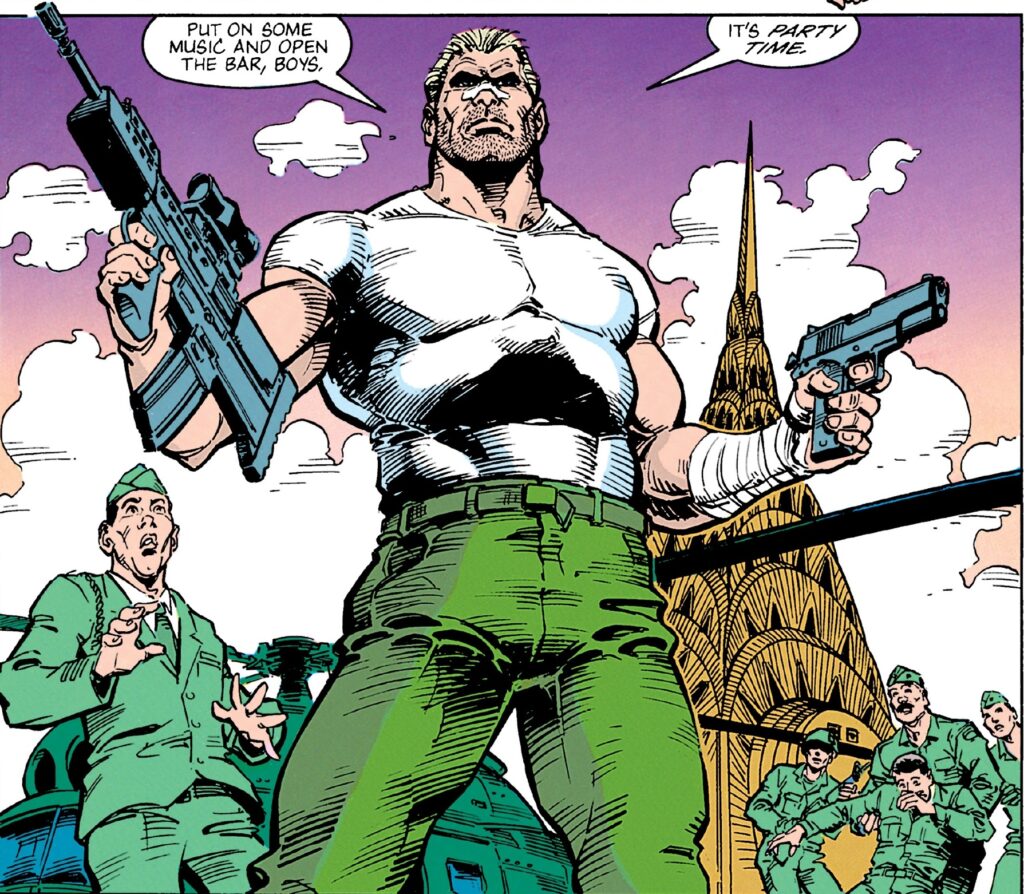
Predator: Concrete Jungle #2
With its foul-mouthed, sweaty badass men (and women), anti-government attitude, and casualty-heavy set pieces, the 1980s’ wave of outrageous action movies had a specific vibe that has become affectionately known in some circles as ‘absurd macho bullshit,’ making this the subgenre that best channeled a zeitgeist of military buildup and coked-up neoliberal excess. The greatest films of the lot seamlessly fused various dimensions: besides delivering streamlined, relentless narratives packed with ‘fuck yeah’ moments, Predator, The Terminator, Aliens, and The Thing actually provided a catharsis to Cold War anxieties through displacement, projecting the conflict against ruthless sci-fi entities.
Comics at the time sought – and often managed – to emulate these movies’ testosterone-fueled brand of storytelling. Mark Verheiden and John Arcudi, in particular, spent much of their early careers writing comic book spin-offs of these licensed properties for the recently created publisher Dark Horse and, for the most part, they did a hell of a job at it.
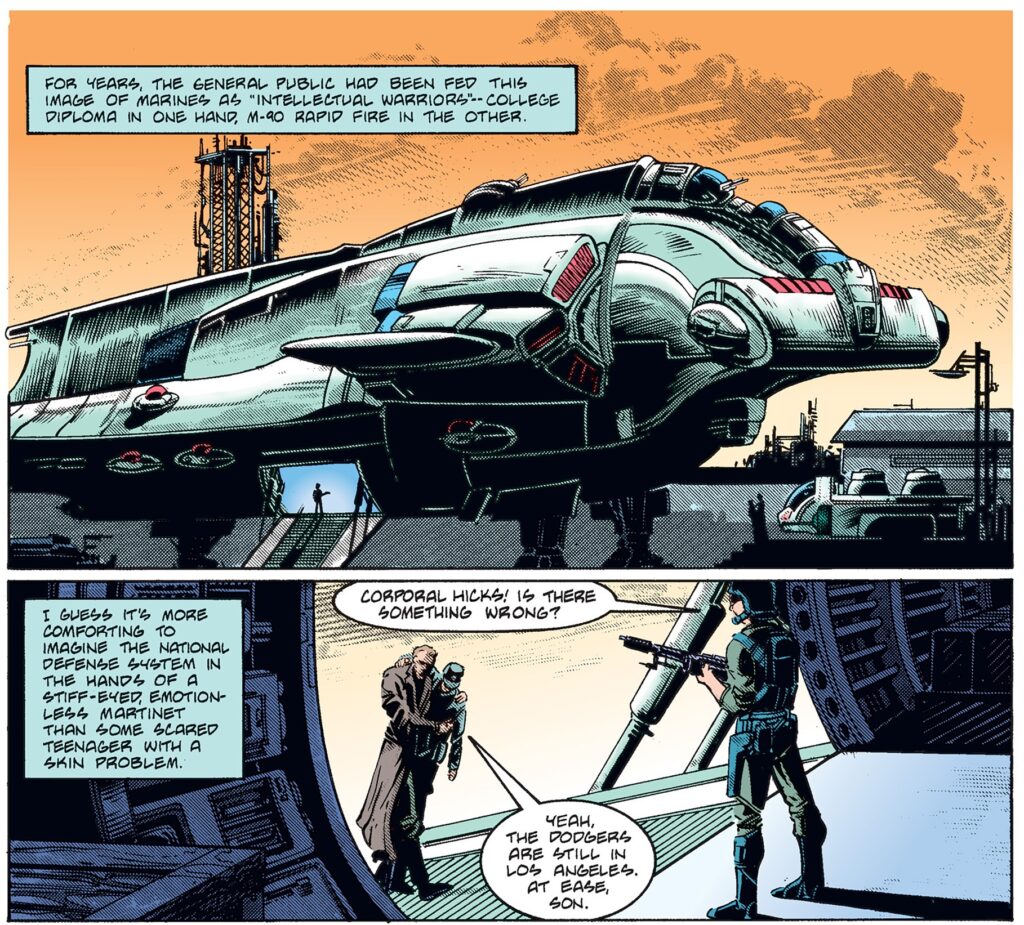
Aliens: Outbreak
It all started when Verheiden penned a bunch of follow-ups to Aliens, beginning with 1988’s Outbreak, about a mission targeting the xenomorphs’ home planet. That comic perfectly nailed the franchise’s misanthropic spirit, with the protagonists screwed both by viciously deadly extraterrestrial creatures and by corporate yuppie douchebags in a dystopic vision of an industrial, rapaciously capitalist future. Thematically, it extrapolated from a variety of trends of the Reagan years, including a great bit with predictions about the evolution of commercial television (‘In a resurgence similar to that seen during the mid-1980s, religious programming became a television staple, outnumbering non-doctrinal programs nearly 100 to 1.’).
Outbreak showed that comics could feel like proper sequels to this type of films, compellingly expanding their world while being way cheaper to produce. Much like James Cameron’s blockbuster, here was a very cool science fiction/horror/war yarn – one with seriously high stakes and worthy additions to the series’ lore (as we learned about new facets of the xenomorphs’ odd biology).
Indeed, for all those disappointed and frustrated souls let down by the way the 1992 movie Alien3 quickly dismissed the set-up at the end of Aliens, this is the story you want to read. The survivors from that second film actually get some solid character development, building on their understandable PTSD, and the plot structure is much more original than in any of the ensuing films… Let’s face it, apart from Prometheus, the movies are all more or less inspired close variations of the same formula and familiar elements (recently remixed once again in Romulus, which Fede Álvarez effectively approached with the sort of unpretentious ‘b-movie’ fun of his Don’t Breathe), but Outbreak actually moves things forward rather than merely repeat the wash cycle. The same goes for the book’s own direct sequel, Nightmare Asylum, which further developed some of these characters – and advanced the series’ posthuman motifs – by placing them in a whole other scenario, before the equally riveting third installment, Earth War.
(When Alien3 came out, Dark Horse preposterously tried to keep these comics in continuity by changing the characters’ names, which significantly reduced the story’s power. Stupidly, that weirdly retrofitted version got republished in Aliens: Omnibus vol. 1, which is why I recommend getting the collection Aliens: The Essential Comics instead… or, you know, just ignore the new names as you read.)
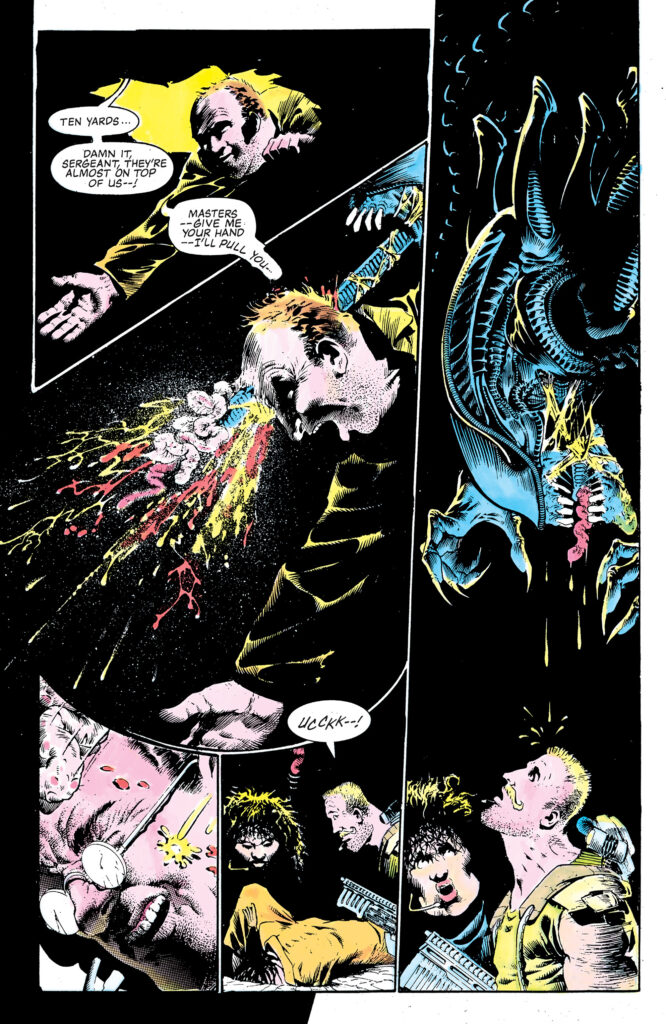
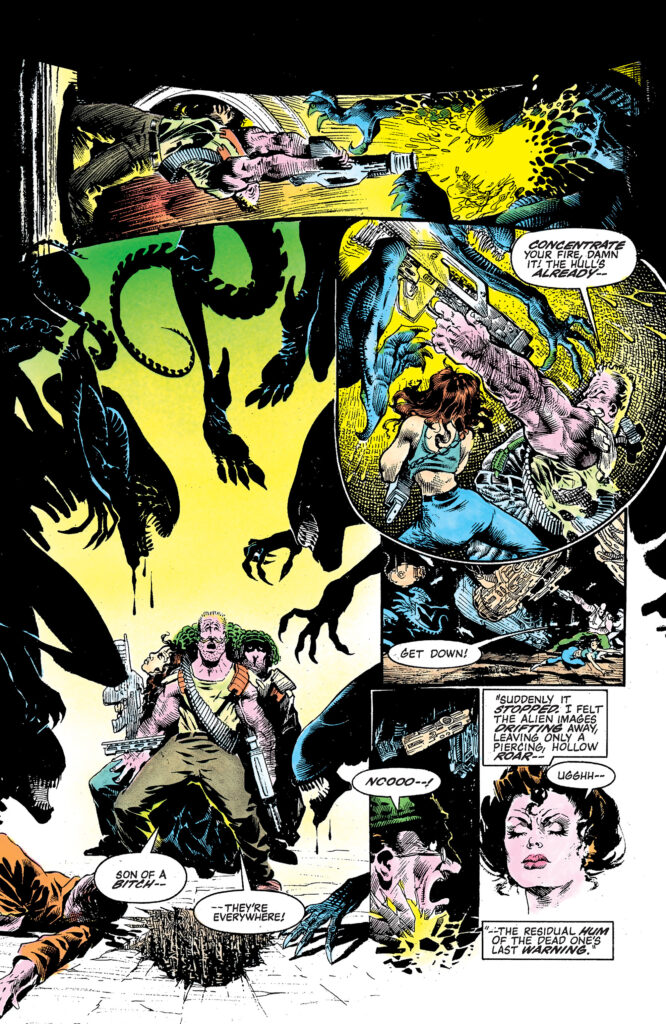
Aliens: Earth War
I also appreciate that these early Aliens spin-offs don’t just read like illustrated screenplays, but rather like damn comics, complete with a clever use of characters’ internal voices. Following Mark A. Nelson on Outbreak, artist Denis Beauvais brought a more impressionistic approach to Nightmare Asylum. Thus, while Mark Verheiden’s narrative struck a fine balance between innovation and familiarity, Beauvais’ stylized painted artwork helped gradually turn the book into even more of its own beast rather than a mere afterimage of the movies.
With the same spirit – but a with very different style – the awesome Sam Kieth then pushed horror to a whole other level when he was brought in for the massively epic conclusion of Verheiden’s trilogy. By the time we got to Earth War, gone was any lingering sense of storyboarding: as you can see above and below, Kieth’s cartooning splattered each page with defiantly unrealistic anatomy and challenging, highly creative layouts.

Aliens: Earth War
In turn, if what you want from this subgenre of licensed properties is a greater sense of aesthetic recognition and fluid continuity from the screen to the page, then the team to beat is penciller Chris Warner and colorist Chris Chalenor, who showed a real knack for transposing the films’ visual style into comic books. Reading their mini-series The Terminator: Tempest and Predator: Concrete Jungle (which originally came out around 1989-1990) really does feel like you’re watching what could’ve been perfectly satisfying sequels to the original Terminator and Predator movies.

The Terminator: Tempest #2
I’m especially fond of Concrete Jungle.
Although John McTiernan’s Predator is one of those near-perfect epics that inevitably loses something by becoming part of a franchise (as its seemingly unbeatable villain is banalized and gradually diminished, softening the initial impact), it still managed to produce plenty of fun sequels on the screen and one the page… A few are really strong (the first Batman versus Predator comic, Nimród Antal’s delightfully schlocky Predators, Dan Trachtenberg’s back-to-basics, revenge-of-the-Comanche prequel Prey) and even some of the ones that are kind of a mess (1990’s Predator 2, 2018’s The Predator) have their fair share of neat moments and ideas.
Concrete Jungle is one of the best. Instead of just relocating the original high concept, it throws everything but the kitchen sink at the reader, as the brother of Dutch Schaefer (Arnold Schwarzenegger’s character), who happens to be a cynical NYC homicide detective, also finds himself being hunted down. The thing is that this is only the tip of the iceberg: before the end of the story, he has to fight off not just a large-scale alien invasion, but also the CIA *and* a Colombian cartel…

Predator: Concrete Jungle #2
There are the obligatory nods to Predator’s most famous moments (‘If it could bleed, it could die.’), but also a handful of looser riffs on stuff like They Live (‘All you have to do is look’) and Rambo: First Blood – Part II (‘Should have guessed, you’re giving me to them.’).
Plus, as you can see, along the way you get all sorts of generic eighties’ action tropes, from New York street gangs to slimy drug pushers, from brutal torture to massive explosions, from awkward Latin American stereotypes to cynical government conspiracies. You even get one of those over-the-top arguments between a police detective and his chief:
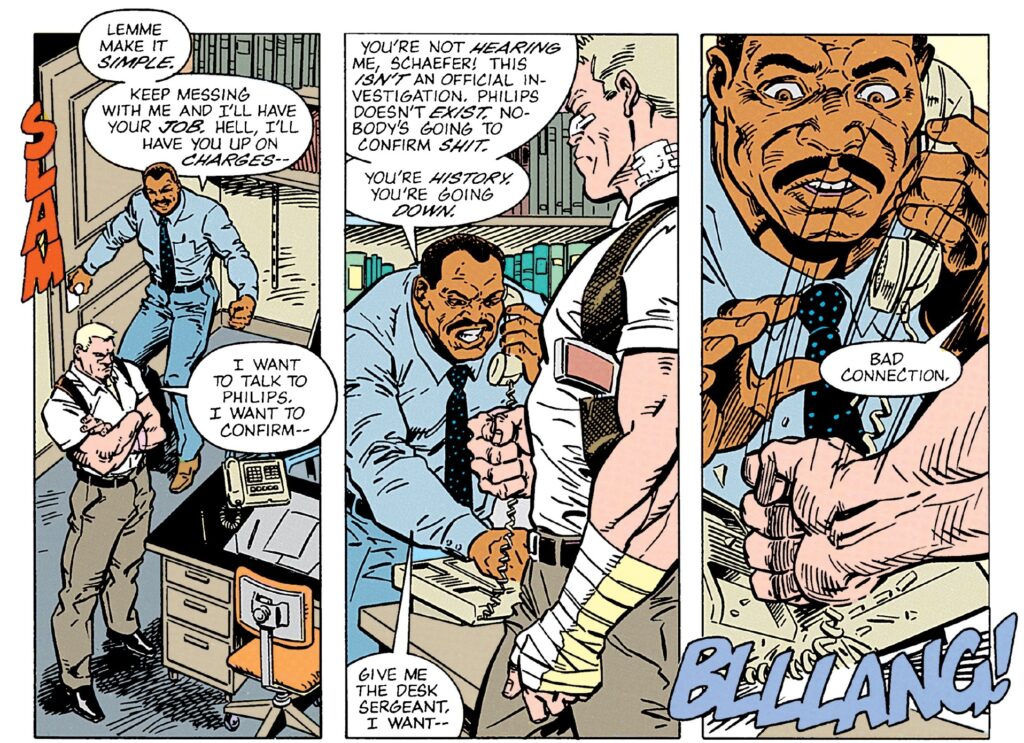
Predator: Concrete Jungle #2
Mark Verheiden’s script is pretty tongue-in-cheek (at one point, a couple of yuppies in the subway discuss the ratings of a show hosted by Charles Manson), but it also delivers the goods, with plenty of badass one-liners and thrilling set pieces.
Verheiden went on to write a couple of follow-ups to Concrete Jungle, with art by Ron Randall. In the same balls-to-the-wall style, Cold War has predators attack a Soviet base in Siberia, gradually generating a geopolitical crisis in a tale that oozes with late-Cold War cynicism (in a classic sci-fi twist, it depicts humans as viciously self-destructive, regardless of the extraterrestrial monsters). Less inspired, Dark River goes back to the American jungle and it even resorts to the lame trope of bringing back characters killed in earlier stories…
The latter misstep may be explained by the fact that, for once, Dark River wasn’t edited by either Randy Stradley or Diana Schutz, two people who clearly knew exactly what to do in order to achieve *just the right vibe*. Fortunately, they did continue to work on this sort of material for a while. In the ‘90s, Stradley penned the first Alien vs. Predator comics (which, needless to say, are much niftier than the subsequent films) and Schutz edited, among others, John Arcudi’s and Evan Dorkin’s grimy mini Predator: Big Game, which went even further in terms of ferociously nailing the first movie’s unabashed rawness:
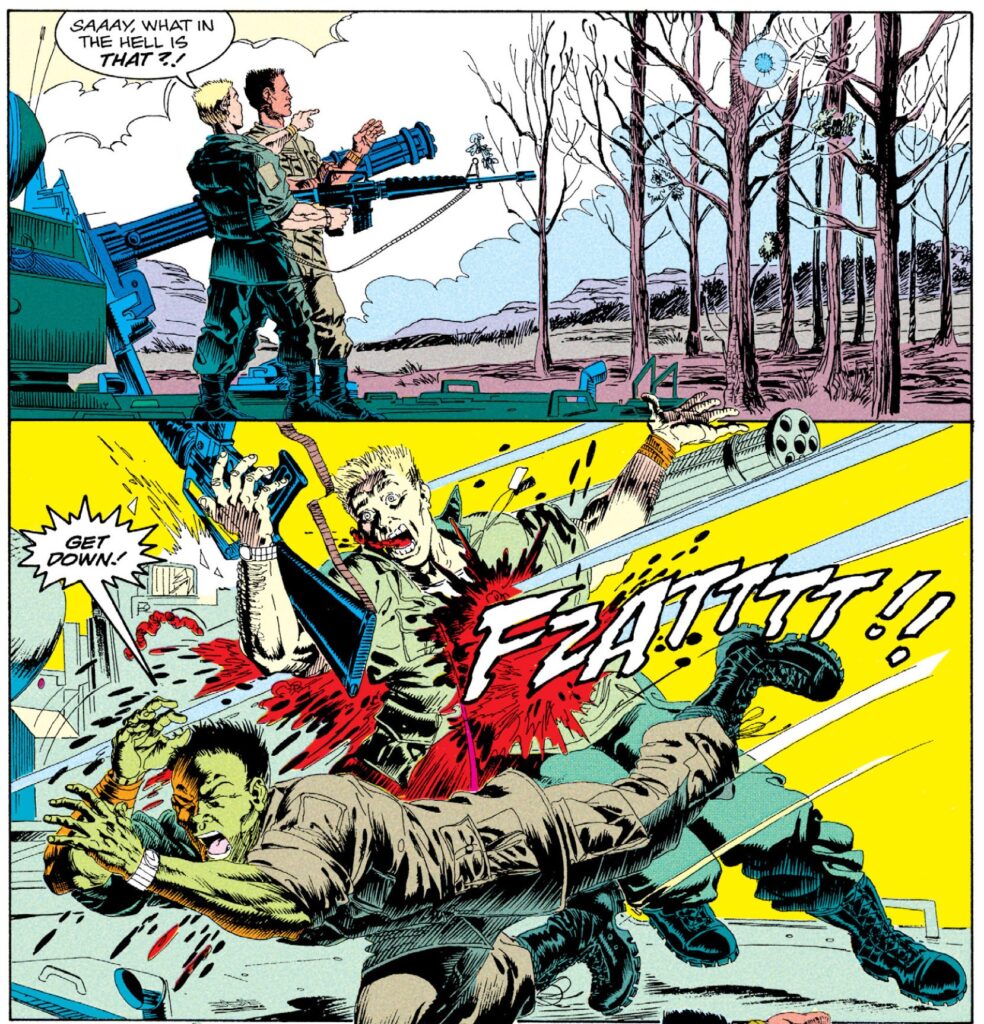
Predator: Big Game
That said, along with licensed properties, there were also plenty of original series that had the same *tone* as Hollywood’s high-octane movies. I’ll be looking at those in a future post…
